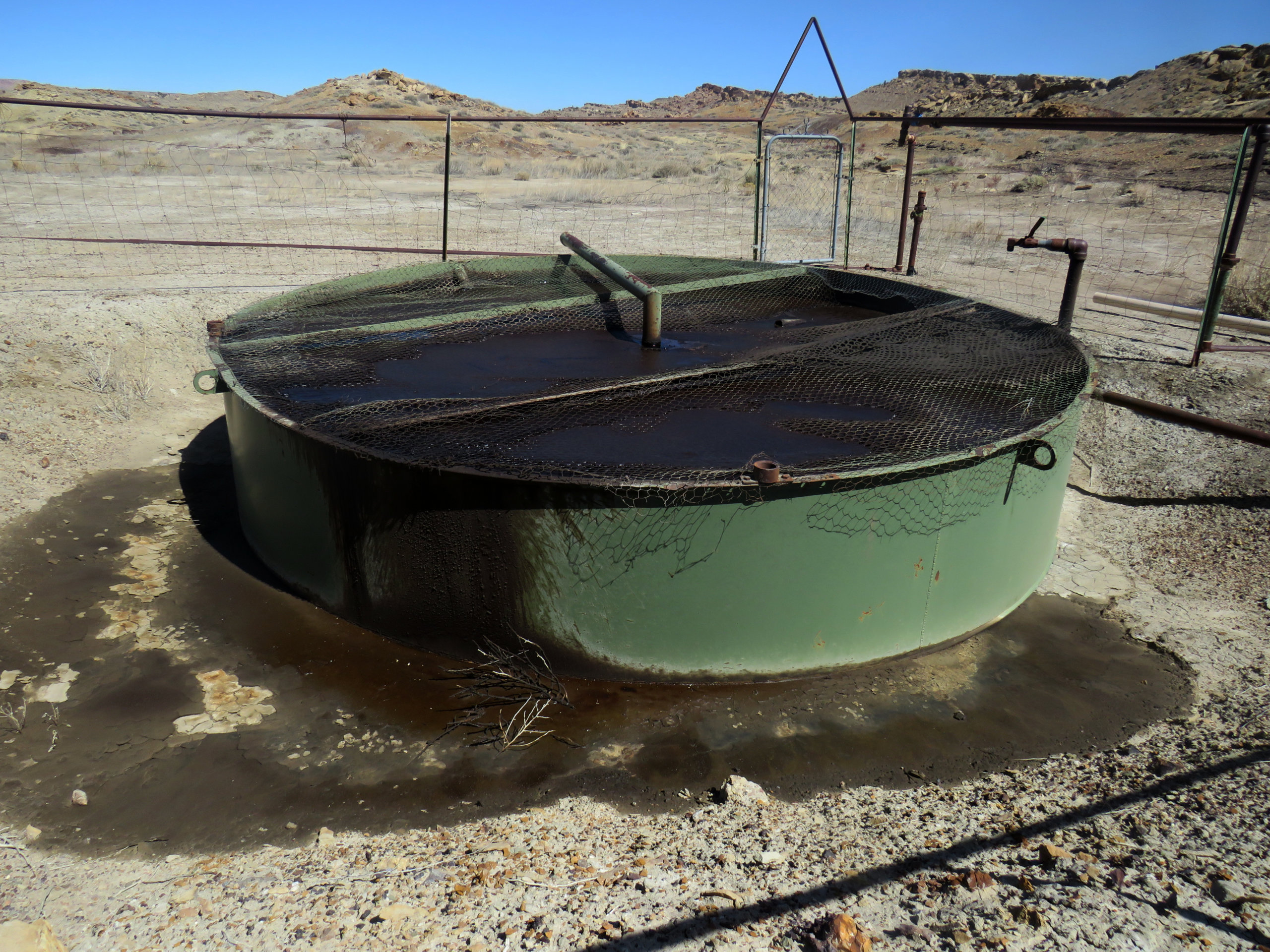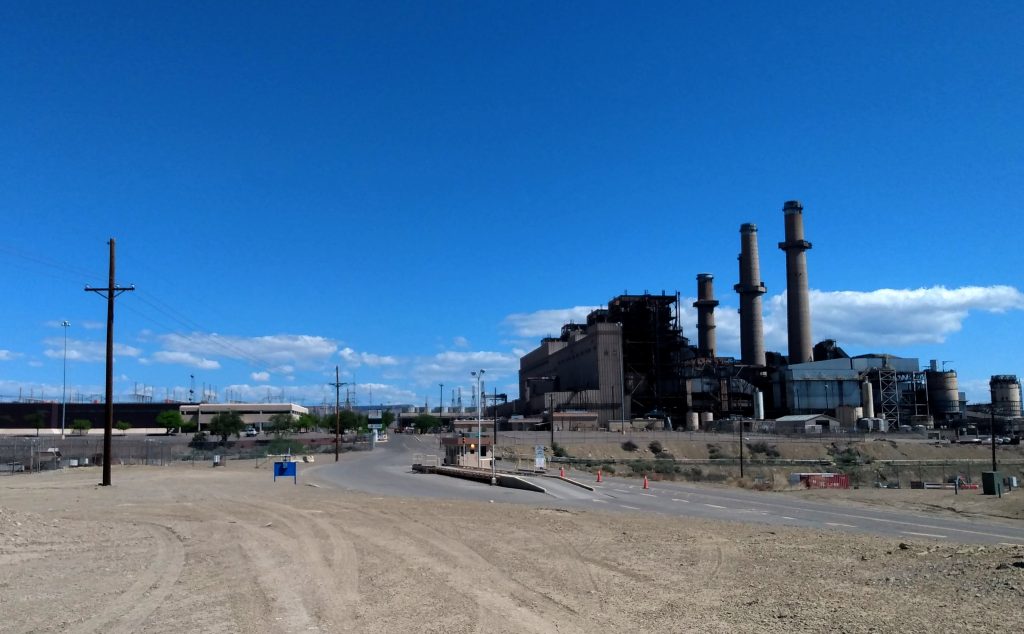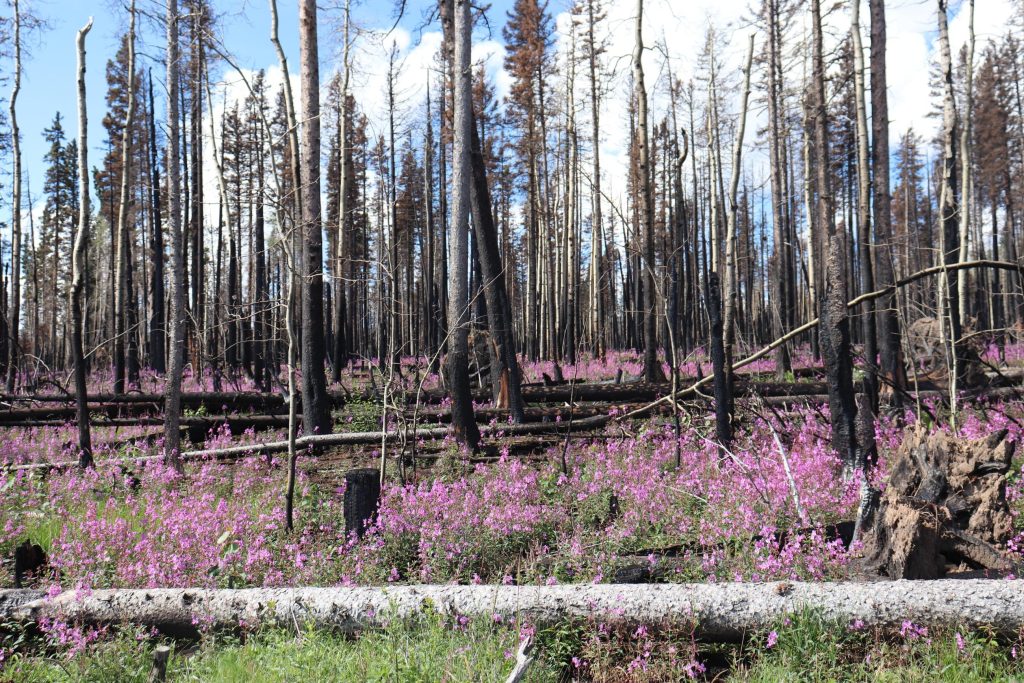Throughout New Mexico, there are thousands of oil and gas wells that have not produced in years but remain unplugged. One area with a high concentration of these sites is the Horseshoe Gallup field, located in the Hogback area west of the San Juan Generating Station in San Juan County.
Environmental advocates have identified hundreds of wells, as well as associated infrastructure, in this field that have not produced in years. Some of these sites are contributing to environmental degradation. This includes leaking methane from a separator tank, overflowing tanks leading to puddles of thick black liquid on the ground and leaking chemicals from containers.
Jeremy Nichols, the director of the climate and energy program for WildEarth Guardians, called these wells “zombie wells.”
“It’s really shameful what’s going on here,” he said.
Last summer, WildEarth Guardians sent a notice of intent to sue to the New Mexico Oil Conservation Division in an attempt to force operators or the OCD to plug these inactive wells, including wells on federal lands. Since then, Nichols said the group has had discussions with the OCD and is still evaluating its next steps.
Once a well on BLM lands is classified as orphaned, OCD Director Adrienne Sandoval said the state works with the BLM to plug it. Sandoval said the OCD relies on a federal grant program for plugging of wells on federal land.
“We basically operate as a kind of a third party contractor and work with them to get things plugged,” she said.
But before the OCD can step in and work to get the wells plugged, the BLM must classify them as orphaned and request that they be plugged.
There are various companies that focus on plugging wells and these companies partner with the government agencies to plug the orphaned wells.
The federal infrastructure act that passed in November provides funding to plug and clean up orphaned wells. In the first round of funding, New Mexico is poised to get more than $43 million.
Related: NM eligible for $43.7 million to address orphaned wells
“The $4.7 billion included in the Infrastructure Investment and Jobs Act to plug and reclaim orphaned wells will immediately reduce heat-trapping methane emissions and reduce local air and water pollution. It’s not every day we get to celebrate that kind of investment protecting our environment and creating jobs in our rural communities,” U.S. Rep. Teresa Leger Fernández, a New Mexico Democrat, said in an email statement. “The next step is to get this funding into the hands of state and tribal officials and then contractors so we can get people to work on actually cleaning the wells up – I know [Interior] Sec. [Debra] Haaland and her colleagues are working tirelessly to get that done.”
Companies are required to issue bonds intended to pay for the clean up should the operator become insolvent, but those bonds are inadequate to cover the full costs.
Related: State faces billions in well plugging costs as Fed buys millions in oil and gas bonds
Sandoval said the OCD plugs 30 to 50 orphaned wells a year and the number of wells that can be plugged in a year depends on funding available.
“With the additional funding, we’re going to be doing a lot more well plugging and reclaiming of sites,” she said.
This doesn’t just include additional funding from the federal infrastructure package. During a December special session, the state Legislature allocated $3.5 million of the money from the American Rescue Plan Act to help the OCD “kickstart our program,” Sandoval said. She said that includes hiring staff. This is intended to help the OCD be more prepared and better able to act when $25 million of federal funding comes to the state in June.
But, while the additional funding will increase the number of wells that are plugged, it may not be enough to fully address the problem.
Related: Analysis finds $8.1 billion gap in New Mexico bonding requirements, clean up costs for oil and gas
Since President Joe Biden signed the federal infrastructure package into law, the number of identified orphan wells in the country has more than doubled and the current number—more than 130,000—is likely low.
The BLM does routine record reviews and inspections of high-priority wells to determine the status and classification. After it declares a well as orphaned, the BLM initiates a process to request federal and state funding for plugging the well and reclaiming the site.
“BLM offices, including the BLM Farmington Field Office, inspect thousands of wells annually and maps out their inspection strategy for the year,” the agency wrote in response to emailed questions from NM Political Report. “The BLM is responsible for conducting the inspections for the Federal and Indian mineral wells under our jurisdiction. The BLM strives to inspect every well periodically, based on risk management, with emphasis on the high priority rated wells, to ensure correct status and classification of wells. If a member of the public encounters a well believed to have been abandoned, we encourage that they keep a safe distance and contact the local BLM Field Office. The BLM will send out a specialist to inspect the location.”
Horseshoe Gallup field
San Juan Basin activists Don Schreiber, owner of Devil Springs Ranch, and Mike Eisenfeld, energy and policy director for San Juan Citizens Alliance, said they were contacted by officials from the U.S. Department of the Interior asking about orphaned wells in the San Juan Basin.
Following conversations with someone who works in the plugging industry, Schreiber went to visit the Horseshoe Gallup field. As he drove away following his first visit, Schreiber said he compared it to desecration of a church.
Schrieber and other activists visited the field again in late March. This time, they were joined by Earthworks thermographers, who brought with them a FLIR camera. These cameras are designed to detect leaks from oil and gas infrastructure.
Eisenfeld said San Juan Citizens Alliance believes that these wells are abandoned and should be considered orphaned.
However the U.S. Bureau of Land Management said there aren’t any wells in the Horseshoe Gallup field that are classified as orphaned.
Many oil and gas wells are located in remote areas and have not been in use in years. These factors, along with the lack of previous attention and funding dedicated to them, have made it hard to know about all the orphaned wells that are out there, according to information from the Leger Fernández’s office. The congresswoman has championed efforts to plug orphaned wells. Some of these wells can be mischaracterized as idle or shut in. Idle and shut in wells are intended to eventually return to production.
That is what Eisenfeld and other activists believe is going on in the Horseshoe Gallup field.
The Horseshoe Gallup field is a checkerboard of land and mineral ownership. Like many parts of the San Juan Basin, the Horseshoe Gallup field includes various archaeological sites. Some of it is Bureau of Land Management while other sections are Navajo or Ute grazing lands. A sign at one point on the Navajo grazing lands warns people not to remove artifacts from archaeological sites.

On the eastern edge of the field, just over the ridge to the west of the San Juan Generating Station, the group stopped at a well named State Senate #2. Initially drilled by Standard Oil in the 1960s, State Senate #2 has had various owners. The one listed on the sign at the site as well as in Oil Conservation Division records is BIYA Operators Inc., although the well has not produced any significant amount of oil for BIYA Operators and the company has struggled financially, even filing for bankruptcy. In 2014, BIYA entered into an agreement to sell the majority of its shares to Diversified Resources of Littleton, Colorado, ultimately becoming a subsidiary of Diversified Resources. BIYA Operators owns 55 of the wells in the Horseshoe Gallup field that have not produced oil in years.
When NM Political Report called the number displayed on the well site, the person who answered said the number is not BIYA Operators’ number. The number listed in the most recent documents filed with the OCD is no longer a working number.
State Senate #2 has an unlined waste disposal pit. These types of pits were banned in 2008 after being linked to soil and water contamination.
Earthworks did not detect any methane leaks at State Senate #2.
The well has not produced oil since 2007, when it produced 24 barrels. In its entire life, State Senate #2 has produced barely more than 1,000 barrels.
Another company name seen out in the Horseshoe Gallup field is Chuza Oil Company, which is listed as the operator on 30 of the wells that have not been producing oil in years.
Chuza Oil Company also had a processing facility in the area. Pipes run from various well sites across the ground to this facility, where chemical tanks can be seen leaking onto the ground and a disposal tank has either leaked or overflowed, leaving a puddle of oil slick on the ground at its base. A truck that was used to transport oil to the facility remains parked near the separator. There’s a five-gallon bucket underneath it that is filled with oil. Earthworks themographer Kendra Pinto found a methane leak in the side of the separator.
Chuza’s name is painted in large letters on the facility. The well closest to the facility last produced oil in 2016 and has produced 12,641 barrels of oil over the course of its life. In 2016, it produced 56 barrels of oil. According to court documents, in 2016, Chuza Oil Company was going through the reorganization process as part of a bankruptcy filing. The well first began producing in 2000 and was drilled by Playa Minerals & Energy Inc., a Texas-based company. In 2003, it was transferred to the Alabama-based company Parowan Operating LLC. Chuza acquired the well in 2011. During the time Chuza owned the well, it produced less than 2,000 barrels of oil.
Down the hill from the facility, there is an injection well or produced water disposal well near what appears to be an old water well that at one time was likely used to provide drinking water for livestock. A concrete trough can be seen beside it.
Like BIYA, Chuza came to the oil field more recently and purchased wells that had already been developed by other companies. Chuza filed Chapter 11 bankruptcy in 2014.

The most recent document filed in the well files for the Chuza well located next to the facility is a letter from the OCD to Chuza dated June 22, 2017. This letter states that the OCD had not received the required operator’s monthly reports since December 2016. The OCD revoked Chuza’s authorization to transport from or inject into the wells that the company operated.
The well did not have a number listed on it for an operator and the most recent number in OCD documents was for the former president, who left in 2015 after accepting a position with the State Land Office. A business listing online states that Chuza Oil Company is permanently closed.
Bankruptcy
One of the ways that wells become orphaned is through bankruptcy, but tracking bankruptcy cases is not enough to determine if wells are orphaned.
“Just because a company goes bankrupt doesn’t mean they’re going to orphan their wells,” Sandoval said.
The state has the inactive well rule, which caps the number of wells that an operator can have inactive. Sandoval gave the example of a company with 1,000 wells. She said that company would only be allowed to have 10 of those wells inactive.
“That’s one of the ways that we try to be proactive and try to prevent a lot of wells from becoming potentially orphaned,” she said.
Last year, Leger Fernández introduced the Orphaned Well Cleanup and Jobs Act, which would increase bonding levels for wells on federal lands and would also establish an idle well fee. This idle well fee would increase gradually based on how long the well has been idle.
Provisions from the Orphaned Well Cleanup and Jobs Act were included in the Build Back Better bill, which failed to garner enough support to make it through the U.S. Senate.
Sacred lands
To the west of the Horseshoe Gallup field, the activists could see Shiprock, known as Tse Bit’a’i to the Navajo, or winged rock. This formation is part of the Navajo’s hero twins story. To the north of the field is Mesa Verde National Park, famous for the ancestral Puebloan cliff dwellings.
Robyn Jackson, the energy outreach coordinator with Diné C.A.R.E., said the area is part of what the Navajo people refer to as the Dinétah. It contains sites and landscapes referenced in the sacred stories.

These areas can be impacted by more than just oil and gas. Jackson highlighted the history of coal mining and uranium mining in the northwest corner of New Mexico.
“That really disrupts the continuation of our culture, of stories, of history being passed on to our people,” she said. “That is disturbing to me.”
Jackson and Pinto said the environmental impacts of oil and gas can be seen in other parts of the Navajo Nation as well.
Pinto said the area around her home in eastern Navajo Nation looks similar to the Horseshoe Gallup field, with pipes lying above the ground and old infrastructure that has been falling apart. Jackson said she has seen similar problems to what was visible in the Horseshoe Gallup area in places on the Navajo Nation like Aneth, Utah, and Red Valley, Arizona.
Pinto’s advocacy roots can be traced to the oil and gas operations near her home in the eastern agency of Navajo Nation, including around Chaco Culture National Historical Park. She had been checking infrastructure in that area the day before heading to the Horseshoe Gallup field.
“They were my neighbors, the industry, but they didn’t care whether I liked it or not,” she said. “They still did their job. They still destroyed.”
Pinto spoke as a member of the impacted communities rather than as a representative of Earthworks.
She said that the destruction and impacts is important to capture the FLIR footage of the emissions and to report it.
Pinto said companies are trying to make millions of dollars off of the wells, but they are claiming there is not enough money to fix the sites.
“I find that very unbelievable,” she said.
Jackson said they saw sites in the Horseshoe Gallup field that were questionable, including some that lacked signage.
“We saw what looked like spills from different chemicals that they use, oil spills,” she said. “Overall these places are hard to get to. The roads don’t look like they’ve been used recently.”
She said accessing the sites to keep an eye on what is going on at them can be hard.
Jackson said she sees a trend of aging oil and gas sites and she does not know how well the companies are taking care of them.
“As a Diné person, this region is part of our homeland, our Diné homeland, that we share with other local tribes,” she said.
Jackson said her father is originally from the Northern Agency and she has family in the Hogback and Shiprock areas.
“But even if I didn’t have family that are from this area, when you’re Diné, a lot of our cultural, spiritual practices and ceremonies, they reference a lot of sacred landscapes that are out here,” she said.
She said it is questionable about whether the sites are being taken care of. She questioned if the area will be available for future generations.
“I don’t know whether clean up will happen,” she said.






















